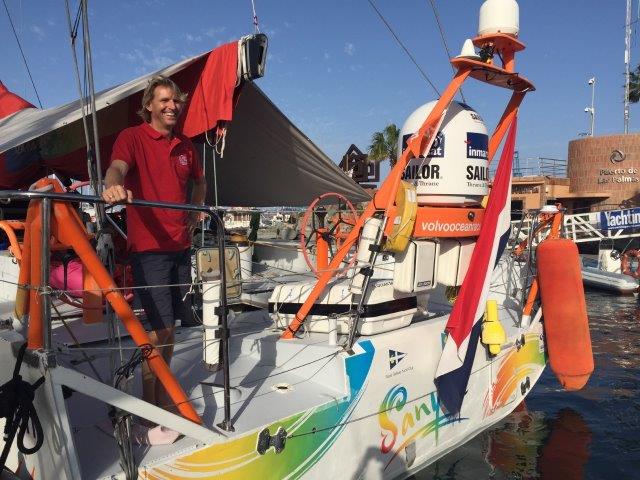Well. That is a question some of the ARC sailors may have pondered when walking along the crowded docks in Las Palmas where cruising boats of many shapes and sizes gather in preparation for the ARC. This year nestled amongst them were several canting-keel race boats, waiting to pounce on the course record, which did indeed fall to the super-maxi
Rambler 88.

Until recently, these grand prix racing machines were the preserve of professional sailors tackling the rigors of ocean racing in the Volvo Ocean Race. However, regular sailors can now have the chance to experience the extreme forces and crazy speeds of these high-tech racing machines in the age of pay-to-sail. One such boat is
Team Sanya, a VOR 70 carbon fibre super-machine now operated as a specialist race charter boat. Skipper Yse Endt invited us aboard to see just how different life is on board a top-end ocean racing boat.
As you step aboard, the first thing that strikes you is how wide they are – over 6m beam on the stern. Safety lines fan out across the deck, there to keep the crew on board. The lack of handholds may also seem odd, until you realise that this boat does not heal like a conventional monohull. In the midst of the hull are two huge hydraulic rams, there to push the keel up and out on the windward side, hugely increasing its effectiveness in balancing the powerful rig that helps drive this oceanic beast. Piercing the deck on either side are two huge dagger-boards, both as deep as the keel. Their job is to control the leeway when the keel is canted to one-side.
The immense cockpit is dominated by the central “control pit” – huge winch drums all controlled by three Harken “coffee grinder” winches, able to operate singly, as a pair or in triple.
“The first thing we get the guests to do it start grinding” laughs skipper Yse. “
Actually the winches are very simple with push button controls on deck. We always have trimmers on the sails and nothing is ever locked down on jammers – the loads are too great” he explains. The heavy sails – some as much as 150kg tend to stay on desk. In fact they are in integral part of the boat’s ballast and need to be constantly moved around to help with the trim. This is defiantly not a boat for anyone unfit!
Surprisingly for such a big racing machine, the boat is very light, just over 13 tons, about the same as a Beneteau First 47.7.
“She’s very enjoyable to sail, helming via the twin wheels is light and controllable,” says Yse.
“Even in big swells, we will power through the waves and aren’t stopped by them. Though this does mean lots of water across the deck!”
Down below, there is very little in the way of comfort for the crew. A small curtain around the gimbaled toilet is the only concession to privacy. A small twin burner gas stove heats water for the dehydrated food, whilst either side of the hull is filled with pipe-cots and rope rails for foul-weather jackets.
First mate Maaike Wassenaar described life at sea. “It gets very noisy down below, with the sound of the water rushing passed the hull and the dagger boards. Plus when we are fully powered up, there is a lot of slamming into waves. Most of the crew use ear-plugs to get some sleep.” Astern of the wide companionway is a small diesel engine and a generator plus a small lifting propeller. “It is just enough to get us in and out of harbour” explains Maaike. A small nav-station, again lying midships is opposite the captain’s bunk, and then a tiny dark “hole”, which was the Media Suite during the Volvo Ocean Race. These boats are made for speed and everything else is secondary. Further aft still are more bunks, slot like with very low headroom under the main cockpit. “We have to crawl into the forward areas to get dressed” says Maaike.
Back on deck in the Saint Lucian sunshine and a long way from the rigors of the southern ocean it is hard to contemplate life for the pros during the race. They must be tough!
So why would anyone want to trade a comfortable cruising boat for a distinctly hot and uncomfortable bunk on a VOR70? “Once you’ve felt the speed of the boat, it is worth all the discomfort” smiles Yse. “At 15 knots the rooster tails are already pushing off the stern – you get used to them very soon. At 20 knots we get more tails from our bow waves. At 30 knots it is really exciting!”